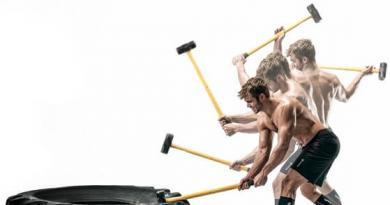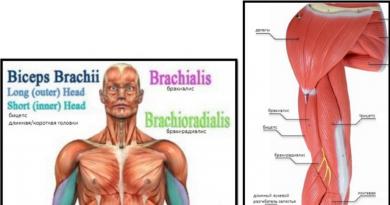Low bow, my dear! For a long time we did not technically and did not understand the practical component of training. Let's do just that today using the debriefing example of the bench press exercise on an incline bench. After reading, each of you will learn all about the benefits, execution technique, secret tricks of the incline bench press. We will also find out what type of bench press is considered the best for the growth of pectoral muscles and what ... well, I won’t reveal all the trump cards in order to keep the intrigue.
So, I ask everyone to take their seats in the auditorium, I give the third call, let's go.
Bench press on an incline bench. What, why and why?
Believe it or not, the bench press exercise is the most massive exercise in any gym. As soon as Monday starts, all the guys rush to the gym as soon as possible in order to be the first to stake out a bench for the bench. Sometimes it comes down to the ridiculous, the corner benches stand pristinely inviolable, and the horizontal one simply has nowhere for an apple to fall, everyone stands and waits for their turn. In this note, I will try to convince you that you won’t be full with one horizontal bench press and you need to (even more so) work out the chest from different angles.
As you know, it is customary to distinguish three sections in the pectoral muscle - top, middle and bottom. To work out each of them, there is its own version of the basic bench press exercise:
- classic (lying on a horizontal bench);
- at an angle up (incline) ;
- at an angle down (decline).
The last two are significantly inferior in popularity to their more eminent counterpart. This is not good, and we will see why later.
Well, we will start, as usual, with the basics of the basics, more precisely, with the anatomical atlas of the barbell press on an incline bench. It is the following picture:

The pectoralis major muscle resembles a fan in shape. Its fibers have different orientations and tension angles from the top to the bottom of the chest. All fibers converge in one place on the humerus of the shoulder. The pectoralis major has two heads: the clavicular head is located on the front surface of the clavicle and the sternocostal head is located on the lateral part of the sternum and 6 upper ribs. These two heads converge near the humeral head:

The clavicular head of the pectoral muscle receives a contractile force when performing a press at an angle up. In other words, the incline press activates the fibers of the clavicular head of the pectoralis major muscle (PCM) to a greater extent, while the horizontal press primarily activates the fibers of the sternocostal head of the PCM. It must also be remembered that when performing incline presses, it is impossible to completely isolate the fibers of the upper and lower chest.
Note:
All further narration on the topic "bench press on an inclined bench" will be divided into subchapters.
Why do we need bench presses at different angles?
Who do you think had the most developed chest in ancient times? That's right, among the gladiators, these guys knew how to achieve its ideal proportions, symmetry of mass and volume. The secret of their quality chest turns out to be simple, and it lies in paying special attention to lagging departments, in particular, the upper one.
If there are variations of the same exercise, then someone needs it ... and you need it first of all for a full-fledged (throughout the volume) development of the pectoral muscles. The classic horizontal press is great for building overall chest thickness and in particular developing the lower and outer pectoralis major. However, one-sided work with a horizontal press will not allow you to create a balanced chest muscle mass with a “thick” upper part.
The lower regions of the chest have more fibers and potential depth of development compared to the upper regions. Therefore, if you do not pay attention to incline presses, then there is a great chance of becoming flat-chested. The upward angle press is designed to build a “high chest” and thereby improve its balance and square shape, like a gladiator.
Advantages
Let's look at what will be good for us from doing the bench press exercise on an incline bench.
The benefits include:
- development of several muscle groups at the same time. The incline press simultaneously engages the pectoralis major / minor, anterior deltas and triceps, allowing you to develop their strength and volume indicators;
- analysis of the EMG activity of the bench press at an angle ( 40 degrees) upward showed a significant inclusion of the fibers of the clavicular head of the BGM;
- helps to overcome the plateau - to improve benching results in the classic variation of the exercise.
Execution technique
In order for the load to target the target muscle group, it is necessary to follow the correct execution technique. The following step by step guide will help you with this.
Step #1.
Go to the bench and set the desired angle of inclination (30-45 degrees). Install the bar on the rack supports, equip it with weight and fasten the clamps at both ends. Lie down on a bench with a barbell grip slightly wider than your shoulders. Bring her to straight arms. This will be your starting position.
Step #2.
Slowly (as you inhale) lower the bar until it touches your upper chest. Hold for one count, squeezing your chest muscles.
Step #3.
After a second pause, with the effort of the pectoral muscles, squeeze the bar up and return it to the PI, while exhaling. Repeat the specified number of times.
In the picture it looks like this:

moving like this...
The exercise has many variations of execution, for example:
- depending on the width of the grip: wide - shifting the load on the shoulders, narrow - triceps;
- depending on the angle of the bench: at an angle 30 , 45 , 60 degrees, upside down;
- reverse grip press;
- bench press at an angle up in;
- dumbbell bench press on an incline bench;
- bench press at an angle up in a power rack.
Here are some visual examples of all this mess:

The following tips will help you perform your incline bench press more effectively. (angled up). So remember:
- the bar should not walk in your hands, otherwise reduce the weight of the burden;
- firmly fix the legs on the floor, focusing on the heel;
- contact with the bench should be made at such points: shoulder blades, sacrum, head, shoulders;
- make sure that throughout the movement you maintain a natural arch in the lower back;
- shoulder blades should be brought together all the time while you are doing the exercise;
- the neck should clearly fall to the top of the chest (collarbone), for this, in some cases, it may be necessary to slightly move the head back;
- lowering the projectile (eccentric phase) should occupy in 2 times longer than lifting (concentric phase);
- at the bottom of the forearm should be vertical;
- never hit the barbell off your chest (disengage inertia);
- lying down on a bench, bend your spine and push your chest forward;
- keep your chest and shoulders off the bench (meaning that should be formed 3 fulcrum - the middle / bottom of the trapezium and 2 it's the shoulders. The chest does not come off the bench from the very top of the back).
Now let's go over the theoretical calculations a little.
Research: Which is Better for Upper Muscle Development?
Now I will surprise you with some news.
When performing a bench press, the full range of chest muscles is involved. There is a belief that incline presses work better on the upper / lower chest, and flat presses on the middle. As I recently learned, this is not entirely true.
Below I will quote one scientific work from “Department of Human Movement Studies” and “Department of Anatomical Sciences”, University of Queensland, Australia.
15 years ago, a study was conducted using EMG (muscle electromyography). The purpose of which was to identify which muscles (and to what extent) affect those or other variations of the bench press. So, it was found that the bottom of the chest is best “hooked” with a horizontal bench press, in comparison with the tilt of the bench up or down. When it came to the top of the chest, the study found that the incline press was slightly more effective than the flat or incline options.
Barbell grip variations have also been studied and found that a narrower stance combined with an upward angle of the bench is the best. (out of all analyzed) variant of the development of the top of the pectoral muscles. The conclusion of the study is this: there is no huge advantage in developing the pectoral muscles when working at various angles ... so don't show off:) press horizontally.
Which bench press is best for growing chest muscles?
If you are used to trusting science, then the above research results will help you decide on exercises for breast development. In addition, I would like to say that by changing the shell from the neck to the dumbbells, you get a “deeper” range of motion and better stretching. These two factors are vital for good pectoral growth.
In total, in order to create a massive chest throughout the volume, be sure to include the following exercises in your training program:
- horizontal bench press;
- at an angle upward;
- bench press at an angle down in the Smith machine.
Well, like this, in this spirit, in this section. This was the last thing I would like to report, let's say goodbye.
Afterword
Today we got acquainted with such an exercise as a bench press on an inclined bench. I am sure that now your pectorals will “snap” in a completely different way, and after a few workouts you will easily catch up with your girlfriend in terms of breast size :).
That's all, I was glad to see and hear everyone, see you soon!
PS. Friends, how do you feel about incline presses, do you use them in your workouts?
P.P.S. Did the project help? Then leave a link to it in the status of your social network - plus 100 points to karma, guaranteed.
With respect and gratitude, Dmitry Protasov.



